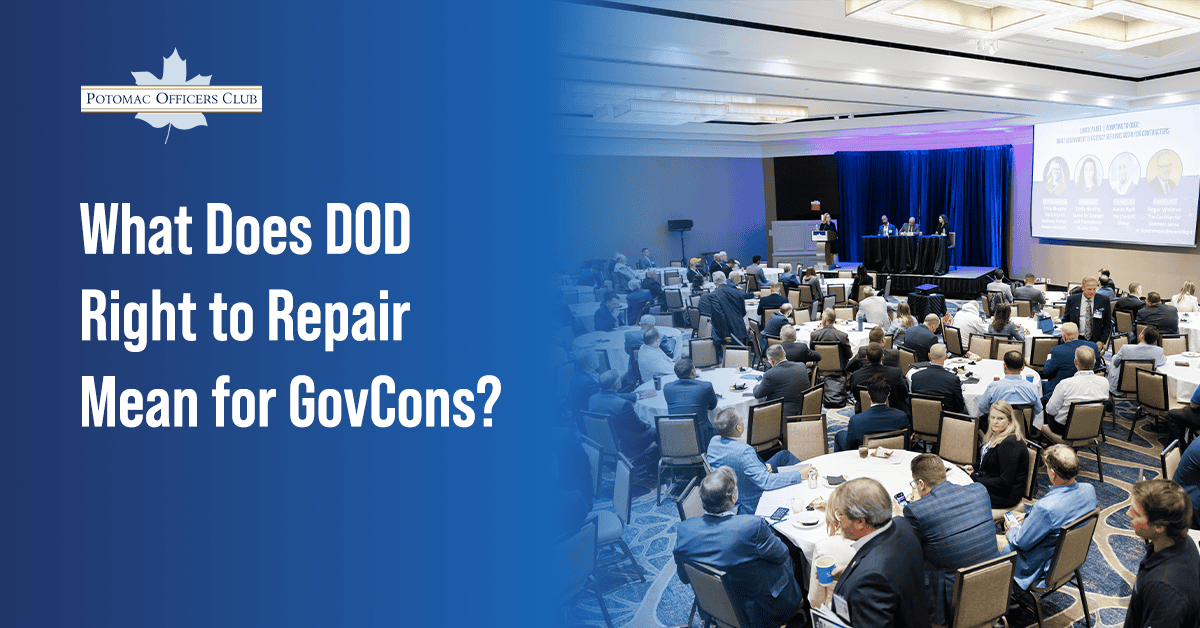
DOD Right to Repair: What Does It Mean for GovCons?
Right to repair has been one of the most contentious topics in government contracting for decades. GovCons seek to secure valuable business sustaining weapon systems they develop for the Department of Defense while the agency seeks to minimize sustainment costs as much as possible.
The stakes in this battle are enormous: DOD spends tens of billions of dollars every year to sustain its weapon systems to ensure they are ready for use in the field and meet future requirements. The Government Accountability Office has estimated that DOD operations and support costs typically account for roughly 70 percent of a weapon system’s total lifecycle cost. This includes expenses for repair parts, depot and field maintenance, and engineering support.
So what is right to repair, and why is it back in the news? Let’s dig in.
The Potomac Officers Club’s 2025 Army Summit is your best chance to learn directly from key Army leaders what right to repair means for your GovCon business. Get the scoop from fascinating panel discussions on topics including operationalizing MOSA with digital engineering. Don’t miss out!
What Is DOD Right to Repair?
DOD procures major weapon systems which, in many cases, it does not have the rights to operate or maintain. Instead, the company that developed and sold the system to the department keeps those intellectual property rights, which permits them to charge DOD for operations and maintenance of the system over its lifetime. Yet, the department does not often acquire the IP it needs to operate and maintain those systems, which can lead to surging costs later in their lifecycles.
DOD has traditionally labored to strike the right balance between its desires to access GovCons’ IP and permitting them to retain control over proprietary information. This has grown in significance over time as the department relies more on industry for innovation.
Additionally, service members can face restrictions on repairing or maintaining their weapon systems in the field when they lack the required IP, making them rely on GovCons. They often run into contract clauses that prevent them from diagnosing, repairing and maintaining weapons and equipment, leading to reduced readiness and accelerated cost growth.
Army Transformation and Acquisition Reform
Right to repair’s momentum with DOD accelerated in late April when Defense Secretary and Wash100 Award winner Pete Hegseth signed an important memo. As part of this decree, dubbed Army Transformation and Acquisition Reform, Hegseth directed Army Secretary Daniel Driscoll to identify and propose contract modifications for right to repair provisions where IP constraints limit the service’s ability to conduct maintenance and access the appropriate maintenance tools, software and technical data. Hegseth also wants Driscoll to push for right to repair provisions in all existing contracts and ensure these provisions are included in all new contracts.
A former high ranking Army official said he laid groundwork when he was serving to help the service better negotiate IP with developers of computing hardware. Gabe Camarillo, former Army under secretary and chief management officer from February 2022—January 2025 and a speaker at the 2025 Army Summit, told the Potomac Officers Club on Monday that he helped create a cadre of IP experts hired on as government civilians.
This team would deploy to different programs at key stages of development to help the contracting and program management teams work their way through right to repair issues. It’s often not a zero sum negotiation, Camarillo said, when the government insists on having all IP and access to it be turned over for government-purpose rights.
There are many ways to negotiate access, Camarillo said, and different ways to safeguard the IP of the vendor base.
“What’s lacking is just the experience and understanding of different ways these issues can be dealt with in the commercial sector,” Camarillo said. “I think that some of those efforts probably need to be continued as the government continues to look at these kinds of issues on right to repair.”
Camarillo said part of the problem has historically been that the federal government needed better expertise to negotiate these types of issues at the right junctures on hardware programs. Typically, IP expertise has been in somewhat short supply across DOD, he said.
Legislative Push Behind Right to Repair
Sen. Elizabeth Warren, D-Mass., of the Senate Armed Services Committee has been a leading proponent on Capitol Hill of DOD taking more control of its IP and right to repair. Warren and Rep. Marie Gluesenkamp Perez, D-Wash., in December co-sponsored a House bill titled the Servicemember Right-to-Repair Act that would ensure DOD retain the right to repair the equipment it owns. This bill, which has been introduced, but has not progressed to the House floor, has many key provisions, including:
- Requiring DOD sustainment reviews to assess the cost-effectiveness of access to IP
- Ensuring GovCons provide DOD with “fair and reasonable” access to repair materials, including parts, tools and information, so servicemembers can repair their own equipment when needed
- Defining “fair and reasonable” as providing similar prices, terms and conditions as those made available to the contractor’s authorized repair providers
Warren isn’t done pushing for more right to repair provisions in DOD. She wants the other military services to take up the requirement, according to the Verge.
The Potomac Officers Club’s 2025 Army Summit will be a gathering of the brightest and leading minds in the Army. Hear captivating keynotes from three-star officers Lt. Gen Jeth Ray and Lt. Gen. Karl Gingrich. Dive into panels on cutting-edge technologies. Create new partnerships with leading GovCon executives and rekindle established relationships. Buy your ticket today!

Category: Articles





